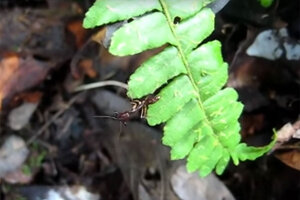How jumpy are trap-jaw ants?
Trap-jaw ants don't just jump, a rarity among ants, they have actually been observed jumping in three distinct ways.

Ants are well known for walking on six legs, and occasionally flying, but when disturbed, some ants get positively jumpy.
Trap-jaw ants, which have powerful jaws that snap shut on prey, use their massive mandibles to propel their bodies out of harm’s way. By snapping their wide mouths shut against the ground or another hard object, the ants fling their bodies backward, away from whatever is disturbing them.
These jaw-snapping backward leaps have been observed previously. But new research shows that some trap-jaw ants can also jump forward using a different, perhaps more expected, body part – their legs.
This new behavior is described in a paper published Tuesday in the journal Frontiers in Ecology and the Environment.
“There are these ants that jump backwards, which is already crazy. But now it turns out that they also jump forward, which nobody has seen before,” study author D. Magdalena Sorger tells The Christian Science Monitor in an interview.
Why jump?
When Dr. Sorger first saw the ants’ forward leaps, she thought they might be jumping to get around the branches and other obstacles in the dense underbrush of the Borneo forest where she was observing them.
“But then when I went back there and I specifically observed them and specifically wanted to know why they jump,” Sorger says. “They never jumped in this context that I had predicted.”
“I’ve observed them [taking] little hops forward through this environment,” she says. But Sorger had been going to the ants’ nests to collect them in vials to study in a field lab, disturbing their environment. When she sat still and just observed, she realized that the ants jumped in response to a disturbance.
“I never saw them jump undisturbed,” Sorger says. So, the leg-jumps seem to be used as an escape mechanism, much like the trap-jaw ants’ frantic backward leaps.
Frantic escape leaps
Trap-jaw ants seem to have little control over their backward jumps, as they often land on their backs.
One way they jump is through an “escape jump,” in which an ant snaps its jaws against the ground. That snap flings the ant up into the air. The other observed backward jump is called a “bouncer defense jump.” In this scenario, the ants snap their jaws against something in front of them, perhaps whatever is disturbing them. This action shoots their bodies backward.
When the ants use their legs to jump forward, they appear to have more control over how they land. Some of the trap-jaw ants' forward jumps reminded Sorger of the way jumping spiders jump.
How unique are these jumpy ants?
“Jumping in ants is rare,” says Sorger.
“Only three out of 326 ant genera are known to jump using their legs: Gigantiops (Formicinae) in tropical South America, Harpegnathos (Ponerinae) in Southeast Asia, and Myrmecia (Myrmeciinae) in Australia, New Zealand, and New Caledonia,” she writes in the paper.
The jaw-snapping jumps have been observed in three types of ants too, Odontomachus, Anochetus (Ponerinae), and Strumigenys (Myrmicinae), Sorger writes.
The trap-jaw ant, Odontomachus, can be found worldwide in the tropics and subtropics. In the United States, fours species of the genus can be found as far North as northern Georgia, says Sorger.
There are many species of trap-jaw ant. Sorger spotted the forward leg-jumps in one species in Borneo, Odontomachus rixosus. As this species appears across Southeast Asia, Sorger is curious to see in future research if the jumping behavior appears outside of Borneo as well.
Observing the leaping insects
Once she spotted the forward-jumping ants, Sorger began observing them. She started by sitting quietly so as not to disturb the ants’ nests for ten minutes. Then she disturbed the nests with a stick and observed their response for 10 minutes.
After watching the trap-jaw ants in their natural habitat, Sorger returned to the field lab for more experiments. There, she gave the ants the choice to jump onto a dark red surface, similar in color to the ants’ own bodies, or a white surface.
“If this is an escape jump, it would make more sense to jump onto the dark surface where there’s less contrast with the ant’s body than on the white surface where the ants will be easier to detect,” she explains. “There was a slight preference to jump on the dark surface, but it was not huge.”
The ants were about 60 percent more likely to jump on the darker surface, she says. Sorger says more research with a bigger sample might help better define why the ants are jumping forward.
In the lab Sorger faced some challenges. “It took me a long time to figure out how to make them jump, which seems straightforward but that probably took me half my time there,” she says.


